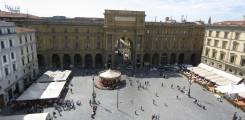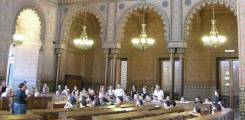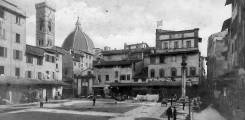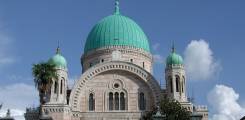This tour begins at the Moorish-style Synagogue. The interior is decorated with wood and bronze carvings, marble floors, mosaics and long stained glass windows. Did you know that the Nazis used the Temple as a garage for military vehicles during World War II? Then, annexed to the Synagogue, there is a small but meticulously arranged Jewish museum with its ritual objects dating back to the 17th century, silver ornaments, embroideries and ancient marriage contracts! The next stop in our tour is the Galleria dell’Accademia where Michelangelo’s David and many other masterpieces are displayed.
After the Accademia, we will visit the religious center of Florence, the Duomo and the Baptistery with its famous ten gold-plated panels depicting the Old Testament, which Michelangelo referred to as the Gates of Paradise. The Benedictine monk, Ambrogio Traversari provided assistance together with a Jewish philosopher in planning the iconography for the doors.
Nearby, we will show you the section marking the former Old ghetto where Piazza Repubblica is located today.
HISTORICAL BACKGROUND
Florence is a famous center for Talmudic studies and has had a continuous Jewish presence since the Roman times. In 1430’s the Medici family officially invited Jews to the city to act as moneylenders. At that time, Jews lived opposite the city center, across the river Arno which divides the city and the life of the Community was relatively stable under the Medici family. Lorenzo il Magnifico defended the Jews from expulsion and from the violent sermons given by Bernardino da Feltre. Then, Pico della Mirandola, a humanist philosopher belonging to the inner intellectual circle of the Medici court, had two important teachers – Johanan Alemanno and Elia del Medigo who taught him Hebrew in order to read biblical and philosophical texts.
A Christian theocracy was installed in the 1490’s under the Dominican friar Girolamo Savonarola, who decreed that both the Jews and the Medici family should be expelled from Florence. A loan from the Jewish community to the Republic postponed the expulsion for a short period of time. Later on, Alessandro de Medici regained influence as a duke in 1531 and abolished anti-Jewish acts. This was the start of the growth of the Sephardic Jewish community in Florence. Refuge was given to Jews from other papal states who left due to Pope Paul IV’s anti-Jewish measures, which were not enacted in Florence.
When the Medici received the title of Grand Dukes of Tuscany, their policies toward the Jews changed for the worse. Cosimo I forced Jews to wear badges in 1567, closed the Tuscan border to non-resident Jews in 1569, shut down Jewish banks in 1570 and established a ghetto in 1571 in Florence and Siena. On the other hand, Livorno was one of two Tuscan cities along with Pisa, which never had a ghetto. It was established by the Medici to be a lively sea outlet for the commercial center of Pisa. Ferdinand I, son of Cosimo, invited Portuguese Marranos to settle here and in Pisa in 1593. They were offered freedom to trade and worship as well as protection from the Inquisition and so the lively Jewish community here became a cultural reference point for the Western Diaspora. In Florence the establishment of the ghetto would mark a long period of confinement for Jewish Florentines which would continue even when the city passed under the House of Lorraine, and would only end in 1848 with emancipation.
Historically, the Golden age for the Jewish community of Florence was in the late 19th and early 20th century when the Jewish ghetto was razed after 300 years of segregation. The Rabbinical college in Florence attracted Jewish intellectuals from all over the peninsula. Today the community of 1,000 has a Synagogue, the Sephardic temple a kindergarten, elementary school, high school, youth club, and Jewish cultural center.
Although the Jewish sacred patrimony of Florence suffered serious losses due to the razing of the ghetto, Nazi occupation during WWII and the flood of 1966, Jewish cultural history remains a precious jewel for visitors to Florence to appreciate and complements the richness of a traditional Florentine tour.








